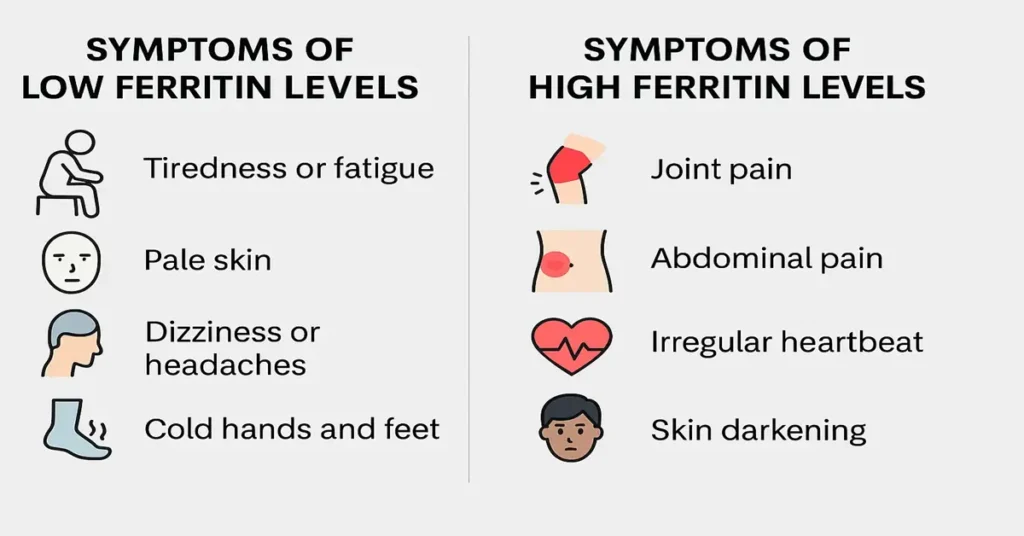Overview
The Ferritin Test is a blood test that measures the amount of ferritin, a protein that stores iron inside your body’s cells.
Ferritin acts as the body’s iron storage warehouse, keeping extra iron in reserve and releasing it whenever your body needs it.
This test helps doctors evaluate how much iron is stored in your body and diagnose conditions such as iron deficiency anemia, iron overload (hemochromatosis), chronic inflammation, or liver disease.
Because ferritin reflects total iron stores, it’s often ordered along with serum iron, transferrin, and TIBC (Total Iron Binding Capacity) tests.
What is Ferritin?
Ferritin is an iron-storage protein found inside cells throughout the body.
A small amount of ferritin is released into the bloodstream, which serves as an indicator of how much iron is stored in your tissues.
If ferritin levels are low, it means your iron stores are depleted.
If ferritin levels are high, it may indicate your body is holding too much iron, often due to liver or inflammatory diseases.
Where is Ferritin Produced in the Body?
Ferritin is synthesized and stored mainly in:
- Liver
- Spleen
- Bone marrow
- Skeletal muscles
These organs act as the main storage sites for iron.
A small amount of ferritin also circulates in the blood, providing a snapshot of your body’s overall iron reserves.
Main Functions and Importance of Ferritin
Ferritin plays several vital roles in maintaining the body’s iron balance and preventing damage from excess iron:
- Stores Iron Safely
Ferritin stores iron in a soluble and non-toxic form inside cells. - Releases Iron When Needed
When the body needs iron — for example, during red blood cell production — ferritin releases stored iron to the bloodstream. - Prevents Free Iron Toxicity
Free iron can react with oxygen and damage cells. Ferritin binds iron tightly, preventing this toxicity. - Supports Red Blood Cell Production
It ensures bone marrow has enough iron to make hemoglobin for new red blood cells. - Maintains Iron Balance
Acts as a regulator, balancing iron intake, storage, and release.
In simple terms, ferritin is like a safety vault for iron, keeping extra iron stored and protected until the body needs it.
Causes of Low Ferritin Levels
Low ferritin usually indicates iron deficiency or poor iron absorption.
It’s one of the earliest signs of iron deficiency anemia, even before hemoglobin drops.
Common Causes:
- Iron deficiency anemia (most common cause)
- Poor dietary intake (not eating enough iron-rich foods)
- Chronic blood loss (menstruation, ulcers, internal bleeding)
- Malabsorption disorders (celiac disease, gastric surgery)
- Pregnancy (increased iron demand)
- Frequent blood donations
Symptoms of Low Ferritin
When ferritin levels are low, the body doesn’t have enough stored iron to make red blood cells efficiently.
Common symptoms include:
- Constant tiredness or fatigue
- Pale or dull skin
- Weakness
- Dizziness or headaches
- Shortness of breath
- Cold hands and feet
- Hair thinning or hair loss
- Restless legs, especially at night
If untreated, low ferritin can cause severe anemia, affecting oxygen delivery and energy levels.
Causes of High Ferritin Levels
High ferritin levels indicate too much iron storage or inflammation in the body.
It can also occur due to liver diseases or chronic infections.
Common Causes:
- Hemochromatosis – genetic disorder causing excess iron absorption
- Multiple blood transfusions – increases iron load
- Chronic liver disease (hepatitis, cirrhosis)
- Inflammatory conditions (arthritis, chronic infections)
- Certain cancers (leukemia, lymphoma)
- Alcohol abuse
- Metabolic syndrome or obesity
Symptoms of High Ferritin
High ferritin often means iron is accumulating in organs like the liver, heart, or pancreas, which can lead to tissue damage.
Common symptoms include:
- Fatigue or weakness
- Joint or body pain
- Abdominal pain or discomfort
- Skin darkening (bronze or greyish tone)
- Irregular heartbeat
- Liver problems (enlarged liver, cirrhosis)
- Diabetes (due to pancreatic damage)
- Hormonal imbalances (thyroid or sex hormones)
If not treated, excess iron can damage vital organs over time.
Reference Ranges for Ferritin
| Group | Normal Range |
|---|---|
| Men | 24 – 336 ng/mL |
| Women | 11 – 307 ng/mL |
Values may slightly vary between laboratories or testing methods.
Sample Type and Test Information
- Sample Type: Serum (blood)
- Tube Used: Red Top (Plain)
- Fasting: Usually not required
- Associated Tests: Iron, TIBC, Transferrin saturation, CBC
Blood is drawn from a vein in the arm, and results are typically ready within a few hours.
Test Preparation
- No special fasting is needed unless other tests are done simultaneously.
- Avoid iron supplements or multivitamins 24 hours before the test.
- Inform your doctor about ongoing medications or vitamin C use (can increase iron absorption).
- If you have inflammation, infection, or liver problems, results may be slightly higher than usual.
When to Consult a Doctor
Consult your doctor if you experience any of the following:
- Persistent fatigue or weakness
- Pale or bronze-colored skin
- Joint or abdominal pain
- Liver discomfort or swelling
- Hair loss or brittle nails
- Symptoms of anemia or unexplained tiredness
Abnormal ferritin results should always be interpreted alongside other iron tests and your medical history.
Your doctor may suggest lifestyle changes, diet modifications, or further testing.
Important Word Explanations
| Word | Meaning |
|---|---|
| Ferritin | A protein that stores iron inside cells. |
| Iron Deficiency Anemia | Low iron levels causing reduced red blood cell production. |
| Hemochromatosis | A genetic condition that causes excessive iron absorption. |
| Cirrhosis | Scarring of the liver due to long-term damage. |
| Metabolic Syndrome | A cluster of conditions increasing heart and diabetes risk. |
| Serum | The clear part of blood used for chemical testing. |
~END~

